|
One
of the things I’ve learned about Freemasonry is that rarely does a single
symbol stand alone in its allusion; rather it shares the same allusion or parts
of the same allusion with many other symbols. This commonality of allusion in
our symbolism is not always obvious, and in many cases the commonality exists as
an overlap with another symbol or allusion. Overlap such as this is a useful
bridging technique, helping us make a connection between related concepts. The
ability to discern such overlap often becomes difficult however when the
overlapping concepts span cultures, languages, time, and in some cases several
different rites and degrees within those rites.
One
such difficult to discern overlap exists in which a similar theme spans cultural
and language differences between the ancient Greeks and the Hebrews; a time
period of several centuries; the Blue Lodge, Scottish Rite, and York Rite; and
multiple degrees in each of these rites. Ultimately, by connecting these symbols
at the overlap (i.e. bridging), we begin to see a common concept emerge of
greater breadth than can be seen by looking at any single piece. The symbols to
which I refer are the Greek (Pythagorean) symbol known as the Tetractys and the
Kabalistic symbol known as the Sephiroth. The bridge which connects these two
important symbols is the Tetragrammaton a glyph representing the ineffable name
of the Deity.
This
paper will examine the Tetractys and the Sephiroth and demonstrate how they are
linked by the Tetragrammaton. It will further explore the commonality in meaning
to be found in the Tetractys and Sephiroth.
We will begin this exploration by examining the Tetragrammaton, which is
the bridge connecting the two symbols. The reader should be aware that this
exploration involves three concepts which could each warrant an entire
book-length discussion. I will provide here no more than a summary of these
concepts with the hope that I will be forgiven for any omissions.
The Tetragrammaton
Literally,
the word Tetragrammaton[i]
means “having four letters” and is the name given to the four Hebrew letters
(Yod-He-Vav-He) which represent the name of God. In the English transliteration
these letters are usually shown as YHVH or IHVH and are pronounced as either
“Yahweh” or “Jehovah”. In
Hebrew the pronunciation is commonly[ii]
Adonai or Elohim depending upon Masoretic or vowel points employed. The use of
the Tetragrammaton to represent the name of God can be positively traced to a
time prior to the 9th Century B.C.E. based upon archeological[iii]
evidence. It is probably much older. In Hebrew tradition[iv],
the actual name of God could be pronounced only by the High Priest and only once
each year on the occasion of Yom Kippur, the Day of Atonement. Over time
(possibly a time corresponding to the destruction of the second Temple), the
correct pronunciation of the ineffable name was forever lost.
There
are many interesting correspondences between the signs and symbols of
Freemasonry and the Tetragrammaton. For example, according to Bro. Manly P. Hall[v]:
“By placing
the four letters of the Tetragrammaton (IHVH)in a vertical column, a figure
closely resembling the human body is produced, with Yod for the head, the first
He for the arms and shoulders, Vau for the trunk of the body, and the final He
for the hips and legs. If the Hebrew letters be exchanged for their English
equivalents, the form is not materially changed or the analogy altered.”
This concept is
illustrated in Figure 1.
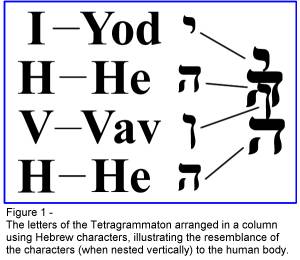 The reader will notice that all three of the penalties of the obligations
for the symbolic degrees are represented in this figure as are the anatomical
points upon which Master Hiram Abif was assaulted by the three ruffians.
The Perfect Points of Entry are also to be found in the nested characters
of the ineffable name. The reader will notice that all three of the penalties of the obligations
for the symbolic degrees are represented in this figure as are the anatomical
points upon which Master Hiram Abif was assaulted by the three ruffians.
The Perfect Points of Entry are also to be found in the nested characters
of the ineffable name.
As
is the case with all the symbols we will be discussing, the Tetragrammaton is
visible primarily in the degrees of the York Rite and Scottish Rite; however
this was not always the case. Ritual has undergone dramatic change over the
centuries, and the Blue Lodge MM Degree at one time directly included the
Tetragrammaton in its symbolism[vi].
According to Mackey[vii]:
"JEHOVAH
is, of all the significant words of Masonry, by far the most important.
Reghellini very properly calls it 'the basis of our dogma and of our
mysteries.'...The history of the introduction of this word into the ritualism of
Freemasonry would be highly interesting, were it not so obscure. Being in almost
all respects an esoteric
symbol... That this name, in its mystical use, was not
unknown to the Medieval Freemasons there can be no doubt... It is now conceded,
from indisputable evidence, that the holy name was, in the earlier years, and,
indeed, up to the middle of the last century, attached to the Third Degree, and
then called the Master's Word...Third Degree refers to 'the mystic word, the
Tetragrammaton.'"
Therefore,
given the aforementioned understanding that the Tetragrammaton was (and still
is) used as a substitute for uttering the true name of God, then the substitute
for the Masters Word in the symbolic degrees almost certainly alludes to the
Tetragrammaton.
The
Tetragrammaton is directly introduced during both the York and Scottish Rite
Rituals[viii]
as a glyph discovered encrusted upon a golden plate during the exploration of a
certain vault. In the Scottish Rite version the golden plate is discovered
resting upon a triangular pedestal. In the York Rite version, the glyph rests
upon a triangular plate atop the Ark of the Covenant and is shown surrounded by
three words encoded using a unique cipher system (commonly referred to by modern
Cryptologists as the “Freemasons Cipher”). There are many variations in the
details which underpin this ritual; in some versions of the Royal Arch ritual,
the plate is triangular, encrusted with Jewels, and affixed to a triangular
stone made of agate[ix]. Regardless of rite,
version, or variation, the Tetragrammaton forms is an essential element in
Freemasonry.
The
Tetractys
The
Tetractys is a figure consisting of ten points arranged in four rows with one,
two, three,[x]
and four points in each row sequentially, and which is inscribed within an
equilateral triangle[xi]
(see center illustration, Figure 2). The Pythagoreans
believed a complex relationship existed between the structure of the Tetractys
and the creation of the physical universe[xii].
Concerning the Tetractys,
Manly P. Hall wrote[xiii]:
“The
mysterious Pythagorean tetractys, or four rows of dots, increasing from 1 to 4,
was symbolic of the stages of creation. The great Pythagorean truth that all
things in Nature are regenerated through the decad, or 10, is subtly preserved
in Freemasonry through these grips being effected by the uniting of 10 fingers,
five on the hand of each person.”
While the Tetractys may be used as either a multiplication or as an
addition device, the more common method of use is that in which the digits of
each row are summed, and the sums of each row are then summed themselves. Thus
for the Tetractys shown in the center illustration of Figure 2 we have 1 X 4 (1
+ 1 + 1 + 1) = 4, 2 X 3 = 6, 3 X 2
= 6, and 4 X 1 = 4. The total of these sums is 4 + 6 + 6 + 4 = 20.
The
Tetractys may also be arranged as shown by the right-hand side illustration
(Figure 2) as a device which employs duple and triple progressions. When arrayed
in this fashion the figure is called the “Lambdoma”. This figure is also
called the “Platonic Lambda” as a result of its its inclusion in the Timaeus
of Plato[xiv]. The sides of the Lambdoma have values of 1, 2, 3, 4, 9, 8,
and 27. Per the Pythagoreans, the
duple progression (1, 2, 4, 8) represents the evolution of the vehicle
proceeding out of unity. The triple progression inverted (27, 9, 3, 1)
represents the development of consciousness. The number 1 is included in both
progressions since it was considered the number from which both progressions
evolved. Generally speaking, the duple progression, being even numbers
represented the feminine, and the triple progression being odd numbers
represented the masculine. The
Tetractys was conceived to represent four Emanations and four planes[xv].
The first Emanation, the Monad, is the source of latent power and corresponds to
a Geometric Point. The second Emanation occurs when the point moves thus
producing a line. This Emanation is called Growth (Auxe)[xvi].
The third Emanation occurs when the line moves creating a surface or plane. This
Emanation is called Skin (Khroia). The fourth and final Emanation is developed
when the surface moves, generating a solid, called Body (Soma).
The
first Plane is the Monad (one), and it corresponds to the virtue Wisdom. The
second Plane comprises the Dyad (two) and the Triad (three), and it corresponds
to the virtues Strength and Courage. The third Plane is comprised of the Tetrad
(four), Pentad (five), and Hexad (six) and represents the virtue Beauty. The
fourth Plane is comprised of the Heptad
(seven), the Octad (eight), Ennead (nine), and the Decad (ten).
The fourth Plane represents the virtue Justice. Beauty,
Wisdom, Goodness, and the corresponding connecting properties, Love, Truth, and
Trust, which are the Chaldaean Virtues all are correspondences of the Tetractys[xvii].
Through the Emanations and Planes the universe was created.
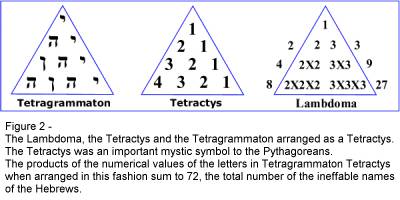 The
Tetractys also represented the four elements air, earth, fire, and water; the
four rows sum to the number ten; This figure is
emblematic of the Tetragrammaton[xviii],
or sacred name of four letters. The
Tetractys also represented the four elements air, earth, fire, and water; the
four rows sum to the number ten; This figure is
emblematic of the Tetragrammaton[xviii],
or sacred name of four letters.
I
would like to concentrate at this point upon the Tetractys shown on the
left-hand side of Figure 2 in which the Hebrew Characters of the Tetragrammaton
are arrayed. The Tetractys of the Tetragrammaton is frequently associated with
the Biblical passage from John 1:1[xix]
:
“En
arched en ho logos, kais ho logos en pros ton then, kais theism en ho logos”
Translated
as:
"In the beginning was the Word, and the Word was with God, and the Word
was God."
Each
Hebrew Character has a corresponding numerical value (See Table 1). This is
similar to the dual use of Roman letters as both alphabetic and numeric
characters.

Based upon the numeric values of the Hebrew Characters shown in Table 1,
the Tetractys of the Tetragrammaton would calculate as follows: 10 X 4 = 40, 5 X
3 = 15, 6 X 2 = 12, and 5 X 1 = 5. The sum of the products would then be 40 + 15
+ 12 + 5 = 72. The number 72 is significant because it represents the number of
ineffable names of God. Naturally, such numerical significance would be of great
interest to Kabalists. In fact, Christian Mystic Jakob Boehme (1575-1624 A.D.)
used a variation of this arrangement as his personal symbol[xx],
and the Tetractys can be found in a form similar to that shown in Figure 2 on
the apron of the 17th Degree of the Scottish Rite. The
number 72 also happens to be the maximum number of Companions in addition to the
Principals and Scribes in a Royal Arch Chapter[xxi].
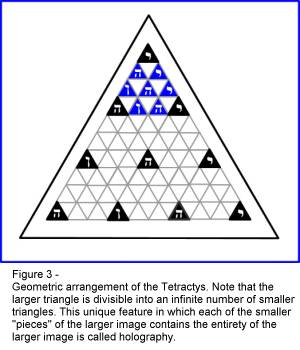 The
Tetractys has an unusual geometric layout as can be seen in Figure 3. A proper
geometric construction can best be made by dividing the Delta triangle into a
series of smaller subsidiary Deltas. Each of these subsidiary Deltas may also be
divided into smaller Deltas and so on ad infinitum. This unique feature, in
which each smaller piece is an exact copy of the original is called holography.
Interestingly, modern scientists believe the universe to be holographic, and
have connected much of the philosophy of the Pythagoreans to Quantum theory[xxii]. The
Tetractys has an unusual geometric layout as can be seen in Figure 3. A proper
geometric construction can best be made by dividing the Delta triangle into a
series of smaller subsidiary Deltas. Each of these subsidiary Deltas may also be
divided into smaller Deltas and so on ad infinitum. This unique feature, in
which each smaller piece is an exact copy of the original is called holography.
Interestingly, modern scientists believe the universe to be holographic, and
have connected much of the philosophy of the Pythagoreans to Quantum theory[xxii].
The
Tetractys displays many more interesting geometric properties, including several
related to the 3, 4, 5 Pythagorean triangle which is a prominent feature of yet
another well known Masonic symbol. Knutson,
Tao and Woodward[xxiii]
studied the correspondence between Tetractys and honeycombs and discovered that
the vertices of the honeycomb form small triangles in a Tetractys. The beehive,
is also a prominent Masonic symbol. I
will further mention in passing that the Tetractys is used as the basis for a
type of poetry in which the first line contains one word, the next two words,
etc. For a closer look at this interesting poetic style used in a Masonic
context, the reader is referred to the works of Bro. Ted Berry at The Masonic
Poets Society[xxiv].
It has been suggested[xxv],
[xxvi]
that “the Tetractys displays the Tree of Life
collected into its most efficient mathematical formation”. The Tree of Life,
or Sephiroth, is itself closely associated with the Tetragrammaton, which, as
mentioned, provides a convenient bridge between the two symbols. Through this
bridge these two symbols may be demonstrated to embody very similar concepts.
The
Sephiroth
Figure 4 depicts the “Tree of Life” or
Sephiroth. Each Sphere (Sephira) in the tree represents an emanation. Each of
the vertical columns of Spheres in the Sephiroth are traditionally considered to
represent a pillar, and each pillar is named according to the central concept
which it represents; thus in Figure 4 we have the pillars Justice, Beauty, and
Mercy left to right, respectively. This figure is a modified version of the
illustration of the Sephiroth which is used in the Knight Kadosh Grade[xxvii]
of the AASR. The modifications consist of the addition of all twenty-two paths,
and the addition of the pseudo-Sephira Daath (Knowledge) between Kether and
Tipareth in the middle pillar. The illustration also includes the Hebrew
Character labels for each of the twenty-two paths and each of the ten Sephira
(other than Daath). Each
of the ten regular Sephiroth are the ten holy attributes which are said to
inhabit spheres of the first emanation of creation[xxviii].
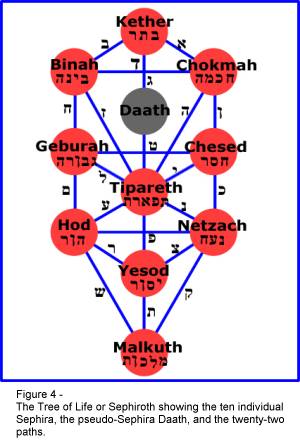 The ten Sephirot are
divided into masculine and feminine Sephira, with those Sephirot on the left
side (left column) being feminine and those on the right side (right column)
being masculine. Each of the Sephira, other than Kether, is also either
masculine or feminine in relation to the Sephira which precedes or follows it. The ten Sephirot are
divided into masculine and feminine Sephira, with those Sephirot on the left
side (left column) being feminine and those on the right side (right column)
being masculine. Each of the Sephira, other than Kether, is also either
masculine or feminine in relation to the Sephira which precedes or follows it.
The
best description of the principles which govern the Sephiroth is perhaps best
conveyed by quoting the first two of the seven ideals of Kabalism[xxix]
as summarized by Dr. Wynn Westcott:
“(1).
God, the Holy One, the Supreme Incomprehensible One, AIN SUPH, is not the
direct Creator of the world. Everything proceeded from the primordial source by
successive emanations, each reaching a lower level than the preceding one.
Hence, the Universe is, in fact, God manifested, the last and farthest removed
production being matter, which is therefore seen as that which is deprived of
perfection.
(2).
All that is known or perceived is formed upon the type-model of the
Sephiroth.”
The
Name of each Sephira, the Hebrew Character by which it is designated, it’s
name, and it’s Correspondence are given in Table 2[xxx].
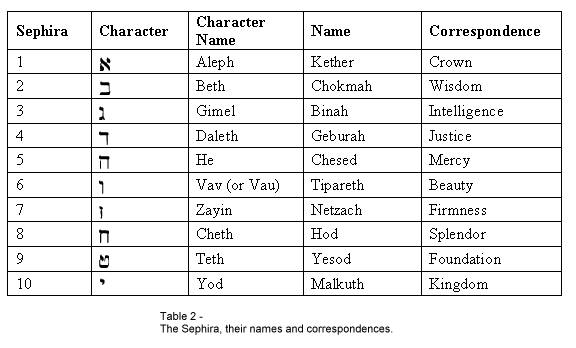
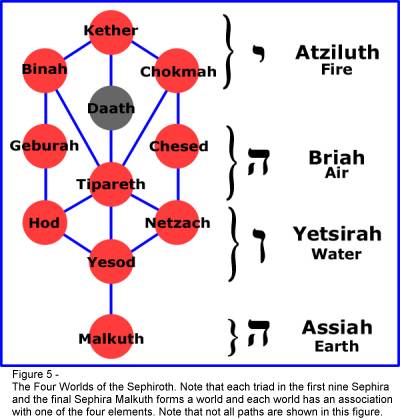 The
relationship of the Tetragrammaton and the Sephiroth is illustrated in Figure 3
in which each of the “Four Worlds” of the Sephiroth are shown. Note that
each World also corresponds to one of the four ancient elements. The
relationship of the Tetragrammaton and the Sephiroth is illustrated in Figure 3
in which each of the “Four Worlds” of the Sephiroth are shown. Note that
each World also corresponds to one of the four ancient elements.
The source of the emanations is described as being hidden by three veils[xxxi]
- “Negativity” (Ain), which
being of three letters alludes to the first three Sephiroth; “The Limitless”
(Ain Soph), which alludes to the first six Sephiroth; and “The Limitless
Light” (Ain Soph Aur), which being composed of nine letters alludes to the
first nine Sephiroth. This complex concept is meant to describe the source as
having Negative Existence and that the limitless ocean of light by which the
Sephiroth manifests itself has no center, but rather concentrates in Kether, the
first Sephira. As can be seen, the depth of the philosophy involved here can be
a bit daunting. The cloud which comprises the Ain, Ain Soph, and Ain Soph Aur,
is rendered below as Figure 6. As an interesting aside I have also provided an
illustration of one well-known version of the Rosicrucian Symbol beside that of
the Cloud of Ain. The similarity is worth noting.
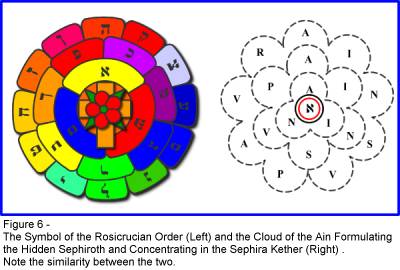 The Sephiroth, much like the Tetractys may be shown to have Geometric
regularity in its construction. In Figure 7, I have provided a construction of
the Sephiroth which is based upon five aligned circles overlapping such that the
circumference of each passes through the center(s) of the circle(s) to which it
is adjacent. The points at which the circles intersect coincide with the center
of the individual Sephira on the left and right pillars, and the circle centers
coincide with the four Sephira (and Daath) in the middle pillar. Circles which
overlap in this manner also form another important Masonic Symbol known as the
Vesica Pisces. The Vesica Pisces may be demonstrated to have certain dimensions
which relate to the Golden Mean; Consequently it is not surprising that the
Sephiroth also contains this enigmatic coding.
The Sephiroth, much like the Tetractys may be shown to have Geometric
regularity in its construction. In Figure 7, I have provided a construction of
the Sephiroth which is based upon five aligned circles overlapping such that the
circumference of each passes through the center(s) of the circle(s) to which it
is adjacent. The points at which the circles intersect coincide with the center
of the individual Sephira on the left and right pillars, and the circle centers
coincide with the four Sephira (and Daath) in the middle pillar. Circles which
overlap in this manner also form another important Masonic Symbol known as the
Vesica Pisces. The Vesica Pisces may be demonstrated to have certain dimensions
which relate to the Golden Mean; Consequently it is not surprising that the
Sephiroth also contains this enigmatic coding.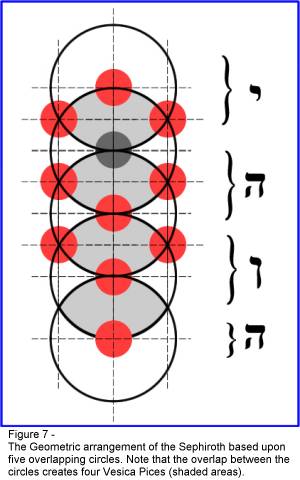
Commonalities
It should be emphasized that the Tetractys and the Sephiroth are not by
any means identical concepts, but rather concepts which share many similarities.
One of these commonalities is that both involve the Tetragrammaton as an
integral part of their meaning. Perhaps the most profound similarity however is
that both propose a concept for the Creation of the Universe, both material and
spiritual, which utilizes a system of Emanations which proceed in stages from
the Divine to the physical universe. S.L. MacGregor Mathers[xxxiii]
clearly believed that the Tetractys system of the Pythagoreans was a refinement
of that provided in the earlier Sephiroth which incorporated mathematical
models. This would be consistent with the reported journeys of Pythagoras to
Babylonia where he would have been introduced to Kabalism. Both systems
incorporate references to the Classical Elements, and both are reported to have
correspondence to the Planets and to Astrology. I would add that both the
Tetractys and the Sephiroth include a left-hand series of Emanations which are
regarded as Feminine, and a right-hand series of Emanations which are considered
Masculine.
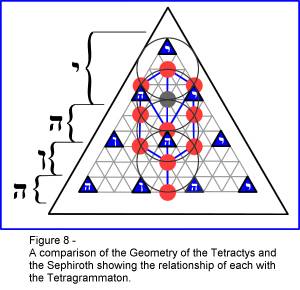 One of the more interesting correspondences of the Symbols used to
illustrate the Tetractys and the Sephiroth however lies in the apparent overlap
between their Geometric layout. Figure 8 shows this correspondence by providing
a composite image of Figure 3 and Figure 7. Note that the Geometries as depicted
coincide. One of the more interesting correspondences of the Symbols used to
illustrate the Tetractys and the Sephiroth however lies in the apparent overlap
between their Geometric layout. Figure 8 shows this correspondence by providing
a composite image of Figure 3 and Figure 7. Note that the Geometries as depicted
coincide.
I
believe that it is a tribute to the genius of the men who developed Masonic
ritual and symbolism that the Tetractys and the Sephiroth are both at the root
of our Craft, and that they provided a bridge by which the two could be joined.
[i]
Tetragrammaton.
(2008). In Merriam-Webster Online Dictionary. Retrieved December 14,
2008,
from http://www.merriam-webster.com/dictionary/tetragrammaton.
[ii]
Tetragrammaton with
Vowel Points for Various Pronunciations. (2007). In Jewish Delaware.
Retrieved December 14, 2008,
from http://jewishdelaware.esmartweb.com/PJewishTexts.htm.
[iii]
Neuhoff, Juergen. (2007). The
Tetragrammaton in the Los Lunas Decalogue.
Retrieved December 14, 2008
from http://www.mhccorp.com/archaeology/decalogue-tetragrammaton.html.
[iv]
Turnbull, Everett
R. & Denslow, Ray V. (1956). A
History of Royal Arch Masonry. Kessinger Publishing, 2004. ISBN
1417950064, 9781417950065
[v]
Hall, Manly P. (1928).
The Tree of the Sephiroth. The Secret Teachings of All Ages: An
Encyclopedic Outline of Masonic, Hermetic, Qabbalistic & Rosicrucian
Symbolical Philosophy. Philosophical Research Society; Revised edition
(June 1978). pp. 121. ISBN-10: 089314830X; ISBN-13:
978-0893148300.
[vi]
Preuss, Arthur. (1908). Study
in American Freemasonry. Kessinger Publishing. 2003.
pp. 172. ISBN 0766156931, 9780766156937.
[vii]
Mackey, Albert G. (1871). Encyclopaedia
of Freemasonry, Vol. I. Kessinger
Publishing Company (2003). ISBN-13: 9780766147195.
[viii]
De Hoyos, Arturo. The Mystery of the Royal Arch Word. Heredom.
Volume 2, 1993. Retrieved December 27, 2008
from Pietre-Stones Review of
Freemasonry. http://www.freemasons-freemasonry.com/royal_arch_word.html
[ix]
De Clifford, Norman
Frederick. (1902). Egypt, The Cradle of Ancient Masonry. Kessinger
Publishing, 1995. ISBN 1564595242, 9781564595249
[x]
DaFoe, Stephen.
(2008), Masonic Dictionary. Retrieved December 26, 2008
from http://www.masonicdaictionary.com/tetractys.html.
[xi]
Weisstein, Eric W. "Tetracyts."
From Mathworld-A Wolfram Web Resource.
http://mathworld.wolfram.com/Tetractys.html.
[xii]
From Absolute Astronomy Retreived
December 26, 2008. http://www.absoluteastronomy.com/topics/Tetractys.
[xiii]
Hall, Manly P. (1928). The
Secret Teachings of All Ages: An Encyclopedic
Outline of Masonic, Hermetic, Qabbalistic & Rosicrucian Symbolical
Philosophy. Philosophical Research
Society; Revised edition (June 1978). ISBN-10: 089314830X; ISBN-13:
978-0893148300.
[xiv]
Plato. Timaeus. Project Gutenberg. Trans. Benjamin Jowett.
Retrieved December 30, 2008 from http://www.gutenberg.org/etext/1572.
[xv]
Cornford, F. M. (1937).
Plato's Cosmology: The Timaeus of Plato Translated with a Running Commentary,
London: Routledge & Kegan Paul.
[xvi]
MacLennan, Bruce. More About the
Tetractys. Retrieved December 30, 2008
from http://www.cs.utk.edu/~mclennan/BA/PT/D-moretet.html.
[xvii]
Opsopaus, John. (2004). A Summary of Pythagorean
Theology, Part V: Theurgy. Retrieved December 30, 2008
from http://www.cs.utk.edu/~Mclennan/BA/ETP/V.html#ascenttoone
[xviii]
Pike,
Albert. Morals and Dogma of the Ancient and
Accepted Scottish Rite of Freemasonry.
Kessinger Publishing; Facsimile edition (March 1992). Ch 29.pp. 602. ISBN-10:
1564592758; ISBN-13: 978-1564592750
[xix]
Ibid. The Wonder of the
Tetragrammaton Tetractys.
Retrieved December 26, 2008 from http://www.helium.com/users/299879.
[xx]
Stephany, Paul. Defining Freemasonry. In Helium.
Retrieved December 23, 2008
from http://www.helium.com/items/658017-defining-freemasonry?page=2
[xxi]
Nullen, Giles C.H. Official History of Freemasonry.
Retrieved December 27, 2008 from http://www.nullens.org/content/view/173/51/
[xxii]
Arkhipov, A.A.
Harmony of the Froissart Theorem in Fundamental Dynamics of
Particles and Nuclei. State Research Center “Institute for High
Energy Physics”. Moscow, Russia. In arXiv:hep-ph/0208263v3 28 Jan 2003.
Retrieved December 27, 2008 from http://arxiv.org/PS_cache/hep-ph/pdf/0208/0208263v3.pdf.
[xxiii]
Woodward,
Chris, Knutson A., & Tao T. (2004). The Honeycomb model of $GL_n$
Tensor Products II: Facets of the Littlewood-Richardson Cone. In Journal
of American Mathematics Society.
17 no. 1, 19--48.
Retrieved
December 26, 2008 from http://www.math.rutgers.edu/~ctw/papers.html.
[xxiv]
Berry, Ted. The Masonic Poets Society. Retrieved December 26, 2008 from
http://masonic-poets-society.com/tetractys.htm#G.
[xxv]
The Tetracyts of the Decad. Abrahadabra Institute Retrieved December 26, 2008
from http://www.abrahadabra.com/tetractys001.htm.
[xxvi]
Tetracyts. All Experts Encyclopedia. Retrieved December 26, 2008 from http://en.allexperts.com/e/t/te/tetractys.htm#hd2.
[xxvii]
Knight Kadosh. The Thirtieth Grade of the Ancient and Accepted Scottish
Rite, and the First Degree of the Chivalric Series. Hirams Web. University of
Bradford. Retrieved
on September 29, 2008.
[xxviii]
Freemasonry in Israel. Retrieved December 27, 2008 from
http://www.geocities.com/Athens/Forum/9991/kabbalah.html
[xxix]
Cleland, J.N. The Kabbalah and Freemasonry. Bonisteel Masonic Library.
Retrieved December 27, 2008 from http://www.bonisteelml.org/THE_KABBALAH_AND_FREEMASONRY.htm
[xxx]
Scholem Gershom. (1990). The Formative Meanings of the Ten Sphiroth/Sephiroth
Belimah. In
Origins of the Kabbalah. Princeton. Retrieved December 27, 2008 from
http://www.psyche.com/psyche/qbl/formative_sephirot.html.
[xxxi]
Mathers, S.L. MacGregor. (1887). Qabalah Unveiled. Reprinted (2006) as
The Kabbalah: Essential Texts From The Zohar. Watkins. London. pp. 26.
ISBN-10: 1-84293-128-9; ISBN-13:
9-781842-931288.
|
![]() News Feed |
News Feed |  Subscribe News by Email
Subscribe News by Email